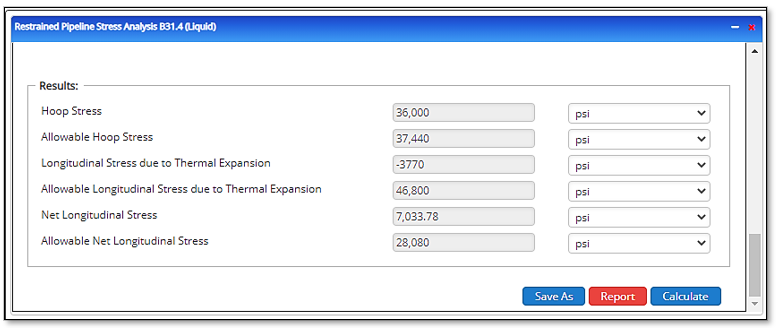Restrained Pipeline Stress Analysis
Restrained pipes are typically buried with proper bedding. However, when settlement or subsidence occurs the longitudinal and combined stresses may be replaced with a strain limit of 2% in ASME B31.4
Yielding that does not impair the serviceability of the pipe. Local stresses caused by periodic or repetitive load resulting in fatigue. Unanticipated earthquakes vibration and thermal expansion.
Hoop Stress

𝑆𝐻 − Hoop stress(psi)
𝑃 − Pipe internal pressure(psi)
𝐷 − Pipe outside diameter(in)
𝑡 − Pipe wall thickness(in)
Longitudinal Stress due to Internal Pressure
𝑆𝑃 = 0.3𝑆𝐻
𝑆𝑃 − Longitudinal stress due to internal pressure(psi)
𝑆𝐻 − Hoop stress(psi)
Longitudinal Stress due to Thermal Expansion
𝑆𝑇 = 𝐸𝛼(𝑇1−𝑇2)
𝑆𝑇 − Longitudinal stress due to thermal expansion(psi)
𝛼 − Coefficient of thermal expansion(1/℉)
𝐸 − Elastic modulus of ambient temperature(psi)
𝑇1 − Pipe Temperature at the time of installation(℉)
𝑇2 − The warmest or coldest pipe operating temperature(℉)
Nominal Bending Stress

𝑆𝐵 − Nominal bending stress(lb/in)
𝑀 − Calculated bending moment
𝑍 − Pipe section modulus(in3)
Stress due to Axial Loading

𝑆𝑋 −Axial loading stress(lb/in)
𝑅 −External for axial component(lb)
𝐴 −Pipe metal cross-sectional area(in2)
Net Longitudinal Stresses
![]()
𝑆𝐿 − Net longitudinal stress in restrained pipe(psi)
Note: The maximum permitted value is 0.9ST
𝑆 − Specified minimum yield strength(psi)
𝑇 − Temperature derating factor
Combined Biaxial Stress

𝑆𝐶 −Combined biaxial stress(psi)
Note: The maximum permitted value of 𝑆𝐶. is 𝑘𝑆𝑇
𝑘 ≤ 0.9−for load of long duration
𝐾 = 1.0−for occasional nonperiodic loads of short duration
𝑆 − Specified minimum yield strength(psi)
𝑇 − Temperature derating factor
Input Parameters
- Select the Restrained Pipeline Stress Analysis application from the Steel Pipe – Design and Stress Analysis module
- To create a new case, click the “+” button
- Enter Case Name, Location, Date, and any necessary notes
- Fill out all required fields
- Make sure the values you are inputting are in the correct units
- Click the CALCULATE button
- Nominal Pipe Size(in)
- Wall Thickness(in)
- Pipe grade (if unknown, use Grade A 24000)
- T – Temperature Derating Factor
- Pipe Internal Pressure
- Pipe Installation Temp
- Pipe Operating Temp
- Nominal Bending Stress(psi)
- Stress due to Axial Load(psi)
- k – Load Factor while providing Poisson’s Ratio
- Young’s Modulus of Elasticity
- Thermal Expansion Coefficient(1/°F)

Outputs/Reports
- View the results
- If an input parameter needs to be edited be sure to hit the CALCULATE button after the change
- To SAVE, fill out all required case details then click the SAVE button
- To rename an existing file, click the SAVE As button. Provide all case info then click SAVE
- To generate a REPORT, click the REPORT button
- The user may export the Case/Report by clicking the Export to Excel/PowerPoint icon
- To delete a case, click the DELETE icon near the top of the widget
- Hoop Stress(psi)
- Longitudinal Stress due to Internal Pressure(psi)
- Longitudinal Stress due to Thermal Expansion(psi)
- Net Longitudinal Stress(psi)
- Maximum Permitted Longitudinal Stress(psi)
- Combined Biaxial Stress(psi)
- Maximum Permitted Combined Biaxial Stress(psi)

Related Links
Table of Contents
Table of Pages
- Pipeline HUB User Resources
- AC Mitigation PowerTool
- API Inspectors Toolbox
- Horizontal Directional Drilling PowerTool
- Crossings Workflow
- Pipeline Toolbox
- Encroachment Manager
- PRCI AC Mitigation Toolbox
- PRCI Thermal Analysis for Hot-Tap Welding
- PRCI River-X
- PRCI RSTRENG
- RSTRENG+
- Ad-hoc Analysis
- Database Import
- Data Availability Dashboard
- ESRI Map
- Report Builder
- Hydrotest PowerTool
- Investigative Dig PowerTool
- Hydraulics PowerTool
- External Corrosion Direct Assessment Procedure – RSTRENG
- Canvas
- Definitions
- Pipe Schedule and Specifications Tables
